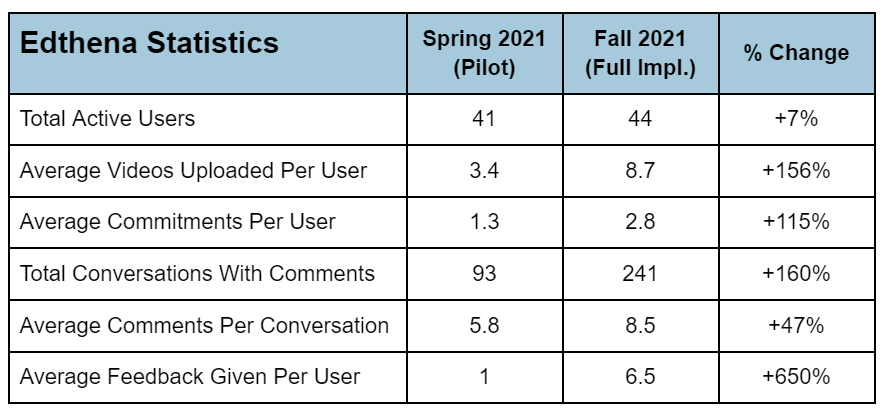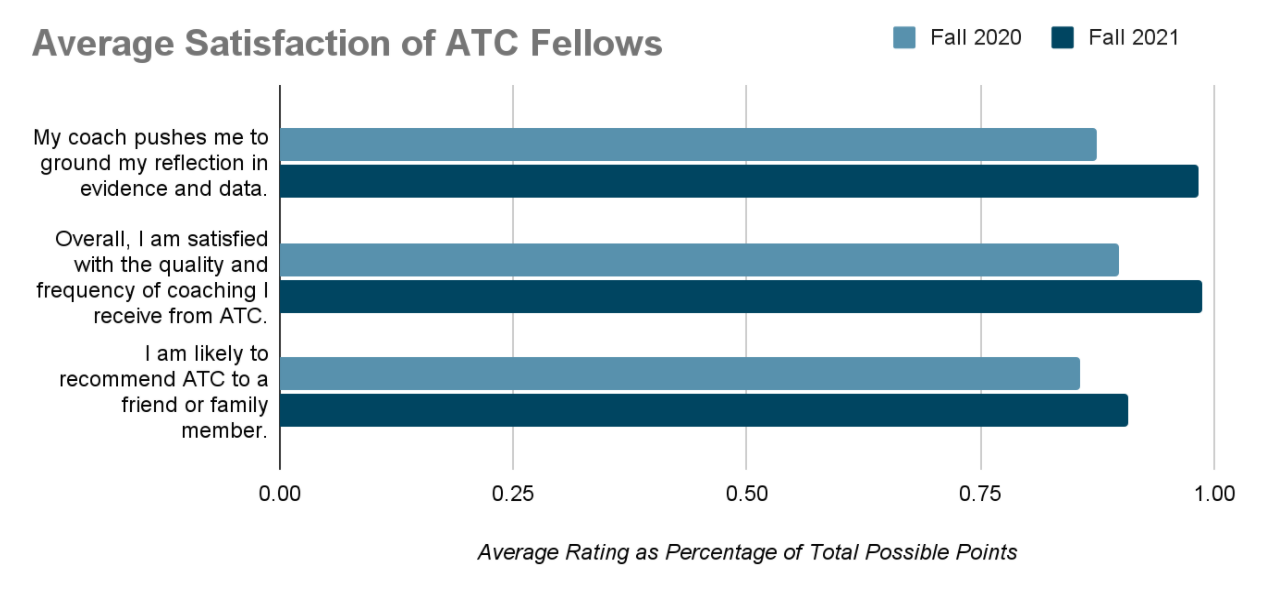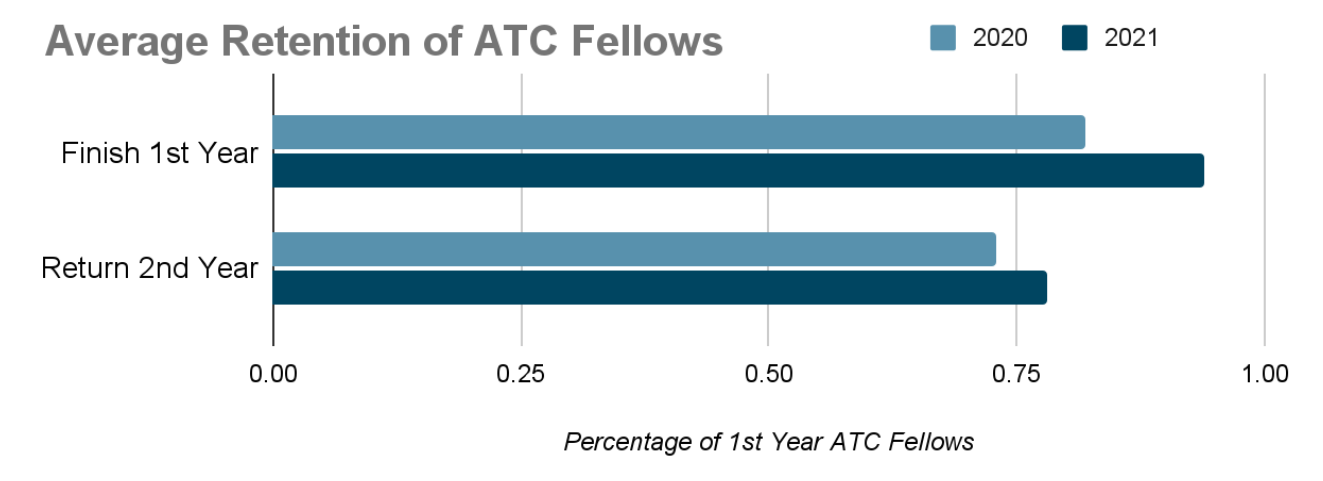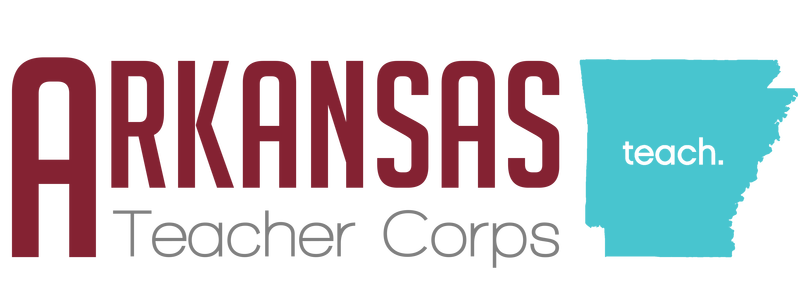Arkansas Teacher Corps made a quick pivot to virtual coaching when COVID hit Arkansas schools in 2020. Since then, our team’s focus on continual learning and improvement have led us to formalize a technology plan, fully implement a comprehensive virtual coaching platform, and see our teacher-fellows make unprecedented gains.
By creating a comprehensive system for virtual coaching in 2021, our team has increased the overall participation of teachers in the coaching process and increased teacher satisfaction with coaching specifically. This has also led to decreased teacher burnout, increased teacher retention, and increased teacher growth compared to the year before.
Going Virtual
When COVID-19 forced the closure of in-person learning in spring 2020, we knew we would have to do something differently to continue supporting the 40+ K-12 teaching fellows in the Arkansas Teacher Corps. The sudden shift to virtual learning left many fellows unprepared to continue engaging students in rigorous, interactive learning; the pivot also prevented our teacher-coaches from being able to visit the fellows, observe their teaching, and give feedback to address student gaps.
As a result, our fellows and their students struggled, and we quickly looked for an online alternative to in-person coaching. Our team first experimented with virtual coaching during the fall 2020 semester, but the lack of infrastructure for virtual coaching meant that our fellows were manually recording and emailing a video for each and every virtual observation.
As the school year began, our teacher-coaches maintained contact with their fellows 400% more frequently than a traditional year to make sure they were getting as much feedback and support as possible. This meant that first-year fellows received two video feedback loops from their assigned coach each week, whereas second and third-year teachers averaged two feedback loops per month.
These feedback loops involved the fellow recording a video, the coach viewing and giving feedback on the video, and a debrief conversation between fellow and coach. Although these feedback loops were integral for fellows’ growth and development, the lack of consistent infrastructure meant much more frustration with the process and more time lost.
Moreover, because many of our fellows had had to master as many as 10 different platforms to implement virtual learning at their schools, we had seen a real need for development in effectively implementing and using online teaching tools. Our team also focused on exploring additional virtual learning platforms and virtual engagement strategies to make sure that we could continue to coach our fellows on increasing student engagement, regardless if they were teaching virtually or in person. As part of this process, we conducted a technology-specific needs assessment and finalized a strategic plan for the purchasing, use, and staff training of technology.
Finding Solutions
With our technology plan finalized, we knew a virtual coaching platform was one of our highest needs and quickly began exploring the various options and offerings available. Our team applied for and received one of twenty 2020 Video Observation Technology Implementation Grants provided by the American Association of Colleges of Teacher Education (AACTE) to pilot the Edthena virtual coaching platform for the spring 2021 semester.
As part of the award, the Edthena success team assisted us in setting up our virtual coaching platform, familiarizing our teaching fellows with it, and establishing goals for use. During the spring 2021 pilot, our fellows practiced uploading one regular-length lesson video per month, in addition to shorter lesson videos focused on specific skills covered in professional development.
At the end of the 2020-21 school year, we evaluated the spring pilot with Edthena and decided to move forward with full implementation of Edthena in fall 2021. New teaching-fellows were trained in utilizing Edthena during the seven-week summer training institute so that virtual coaching could begin from day 1 in the fall. Similar to last year, our coaches again maintained a 400% increase in communication over historical trends while reviewing two lessons and giving feedback to 1st year teachers every week.
Unlike before, however, the “exploration” feature of Edthena allowed our team to setup small-group professional learning communities in which teachers could either directly record within the app or upload a video from an external source. For virtual observations, coaches conducted two per week with first-year teachers and two per month with second- and third-year teachers.
Seeing Results
With the added ease of the Edthena infrastructure, our fellows increased the average number of uploaded videos by 156% and our coaches provided 650% more feedback on average per fellow. The table below shows the change in other usage statistics from the spring 2021 pilot to full implementation of Edthena in fall 2021:

Furthermore, given our team’s transition to Edthena, we saw an increase in fellows’ overall satisfaction with the coaching we provide in addition to this increase in fellows’ participation. Following implementation of Edthena, 100% of our fellows report satisfaction with the quality and frequency of coaching they receive.
One fellow said, “I think the coaches and employees at ATC work hard to create a supportive culture. I know I can depend on my coach for literally anything and everything.”
Another said, “[My coach] is a great coach! She is always positive, even when the feedback she gives you isn’t. She challenges you to grow and helps you see the growth in yourself that you may not see.”
And, a third said, “[My coach] has been an amazing coach. Her feedback has been clear and actionable which has helped me tremendously. I know I can always reach out to her with anything.”
Our fellows are also much more likely to ground their reflections in evidence and to recommend ATC to a friend or family member. The chart below shows the change in average survey ratings for fellows as a percentage of the total possible points between fall 2020 and fall 2021:

Not only have fellows reported an increase in satisfaction with the coaching they receive, but they have also reported an average decrease of 7% in burnout based on survey items from the Maslach Burnout Inventory (Maslach et al, 1997). The increased satisfaction and decreased burnout have meant that more teaching fellows have remained in the classroom: in 2021, we saw a 10%-point increase over our historical average of first-year teachers who both finish their first year and return for a second year.
The chart below shows the percentage of first-year ATC fellows who finished the year and returned for a second year in 2021 compared to 2020:

Throughout 2021, as fellows remained in the classroom at higher rates than normal and received unparalleled virtual coaching, we also saw fellows performing at a higher level with students. One of the virtual observations at the end of each semester is a formal evaluation based on the Arkansas Teacher Excellence & Support System (TESS) rubric used statewide.
In fall 2020, only 19% of fellows met the growth benchmark from the previous year, whereas 32% of fellows met growth in fall 2021. Moreover, at the individual level, fellows in fall 2021 increased the amount of growth they experienced by 1,036%, or 2.48 standard deviations, over the previous year.
The chart below shows the amount of average growth experienced by fellows in fall 2021 compared to fall 2020:

This increase in efficiency and service has not gone unnoticed either! The Edthena Success Team has taken notice of the dramatically higher participation rates and have been actively recognizing the work our team is doing. The Edthena team has recommended us for recognition and inclusion in various national educational news like District Administration.

